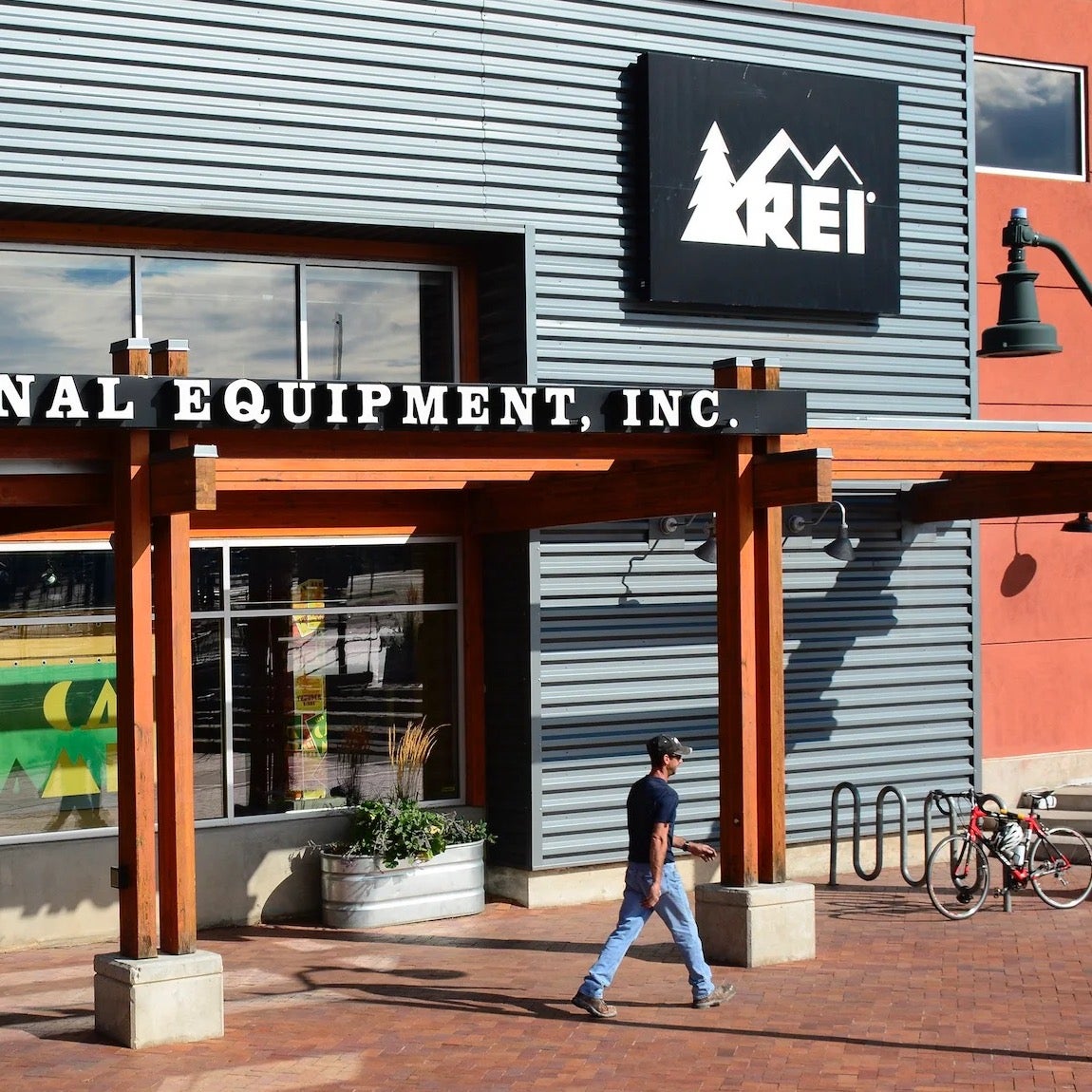When Lloyd and Mary Anderson founded REI in 1935, the last thing they had on their minds, probably, was running. The two climbers started what eventually became the co-op by selling affordable, quality ice axes, and it was there—in the hardcore climbing space—that the retailer largely remained for decades.
It wasn’t until 40 years later, in 1975, that the business even expanded beyond its home city of Seattle, which was at that time mostly a hub for the buying and selling of climbing gear. As the U.S. outdoor market began to take shape in the last few decades of the twentieth century, however, REI gravitated—at first gently, and then with increasing speed—to the middle ground of adventure retail, selling a little bit of everything to just about everyone. Bikes, skis, kayaks, general fitness, and travel gear became part of the expected offerings when shoppers walked through the co-op’s doors. And in that lucrative, widely customered territory, REI ascended.
Earlier this year, as it has done many times in the past, REI once again fixed its gaze on fresh quarry: the running space. Running goods have intermittently accounted for a meager slice of the retailer’s stock since the 1980s, but it wasn’t until April of this year, when the company announced it would expand its offerings of gear, expert resources, and community support in the vertical, that the co-op made it a focal point.
A Canny Category Play
The business motives behind the move are uncomplicated. With the bump in running participation over the last couple of pandemic years, expansion into the vertical is a savvy move, said Matt Powell, senior sports industry advisor at the market research firm��The NDP Group, who expects running-shoe sales to outperform sales of all other types of athletic footwear in 2022.
REI’s own data line up with the assessment. According to Fan Zhou, REI’s newly appointed run activity director, the company’s running business has grown more than 65 percent since 2019. “There are three big reasons we see running as important,” Zhou said. “First, we see frequent engagement. The median number of days a runner participates hits between 150 and 200 per year.” Second, said Zhou, running is REI’s most popular category��among Asian, Black, and Latino customers. This is a large and diverse group the co-op hopes to introduce to its wide offerings by using running as an onramp. Third: “We see significant overlap between runners and [participants in] other activities,” Zhou said. “We found that 50 percent of runners also cycle, and 40 percent of runners also hike or camp. When we think about servicing customers, we believe running is a great entry point.”
Despite the sales potential, REI representatives are quick to use words like “organic” when discussing the move. Chris Speyer, vice president of product at the co-op, said that any time the retailer has expanded into new categories in the past, it has always been the result of a natural evolution of the customer base. Ski equipment, for instance, started cropping up on REI shelves in 1939 mainly because many of the co-op’s original ice-climbing members also liked to ski. “By natural evolution of being on trails and in the mountains, many of our verticals extend into others,” Speyer said.
Running is REI’s most popular category��among Asian, Black, and Latino customers. This is a large and diverse group the co-op hopes to introduce to its wide offerings by using running as an onramp.
This year’s run expansion includes no small measure of that organic crossover, but the move does distinguish itself in some ways—chief among them its sense of purpose, of orchestration, the whiff of corporate savvy hanging about it. One feels, in the strategy, the desire not just to find new markets but to create them, to gently cajole almost-REI customers into shoppers walking through the door.��“When we think about growing our member base, we’re looking at including a younger, more diverse urban or suburban customer,” said Speyer. “We’re reframing how we can be relevant to someone who wants to get outside.”
Changes to Expect, Large and Small
What we’ll see in-store, now that the strategy is in motion, is first and foremost an explosion of product offerings in the category. REI’s shelves, from now on, will feature no fewer than 50 different running brands. As recently as last year, the co-op’s running-shoe line mostly ended with trail models; now, members will be able to find everything they need for road running as well: On Running, Brooks, New Balance, Saucony, and many others in addition to the longstanding offerings of Salomon, Merrell, and Hoka One One.
It’s a signal of REI’s strength in the market that brands themselves are taking note of the change and responding in kind. Chris Cohen, vice president of sales at Hoka, said that given REI’s new strategy, the brand has made the decision to extend its range of products in-store to include more road models. “We consistently think about the consumer experience that any given access point provides,” Cohen said. In other words, if the “experience” at REI is widening to welcome more runners into the fold, there’s no reason Hoka’s sales strategy should involve sending customers to two different stores—REI for hiking boots, say, and a local running shop for marathon trainers—to get what they need.
Anyone who has been into an REI recently has probably noticed the apparel, too. Running-adjacent lifestyle brands seldom seen on the co-op’s shelves in years past, like Vuori, have started making appearances. REI has even added its own line of running clothes, called Swiftland, into the mix, targeted at urban and trail runners alike. “There’s a perception that REI only serves the backcountry runner,” said Speyer. “We need to change that narrative. Our customers can be urban 5K runners, too. We want to serve them as well.”
One customer who might be tough, if not impossible, to reach is the experienced road runner with a deep sense of loyalty to his or her local specialty store. “We may not be compelling to the competitive road runner,” said Speyer. “But we think we can coexist with specialty shops.”
For folks like Stephen Sweezey, manager of one such shop—Running Hub in Santa Fe, New Mexico—such coexistence might even be additive for the little guy, if not for REI, in the long run. “REI serves a pretty broad population,” said Sweezey. “If someone starts at REI and really gets into road running, hopefully they’ll eventually find us. When customers get to the point where they’e looking for more specialized equipment and advice, that where we excel as a specialty shop.”
In truth, though, the hardcore road runner notching multiple ultramarathons every year is no more the co-op’s target clientele than the hardcore mountaineer putting up first ascents or setting fastest-known-time records on punishing peaks. Where the run expansion is already resonating at REI, said Speyer—and probably right where the company wants it to—is among “social,” everyday runners. That’s where the big money is, after all. “Many of our members are already runners and couldn’t find their needs here,” Speyer said. “Now they will have the convenience of finding everything under one roof.”
Or, maybe, under no roof at all. The co-op’s full lineup of running shoes and gear is now available online. “Some 40 percent of all athletic footwear is sold online, so they’re making sure to capture this piece of the market as well,” said Powell of The NPD Group. “REI is formidable in e-commerce, so expect them to be competitive here, too.”
One customer who might be tough, if not impossible, to reach is the experienced road runner with a deep sense of loyalty to his or her local specialty store.
At the end of the day, few retailers can match REI’s heft and reach, so it’s fair to assume the ripple effects of this new category push will be significant. Smaller, more hardcore running shops might have cause to worry if there’s a co-op location nearby, but then again, those retailers tend to have dedicated, loyal followings—people who need gear more specialized and niche than what REI can feasibly offer precisely because of its size.
As for everyone else, the linkage of “running” and “REI” in the consumer awareness has yet to coalesce, and there’s no telling if, and how strongly, it will. Anyone familiar with the co-op’s near-century of constant change and constant success probably wouldn’t bet against it, but in today’s rapidly changing industry landscape, nothing’s a shoo-in—even at the retailer some call too big to fail.
Steve Larese contributed reporting.


